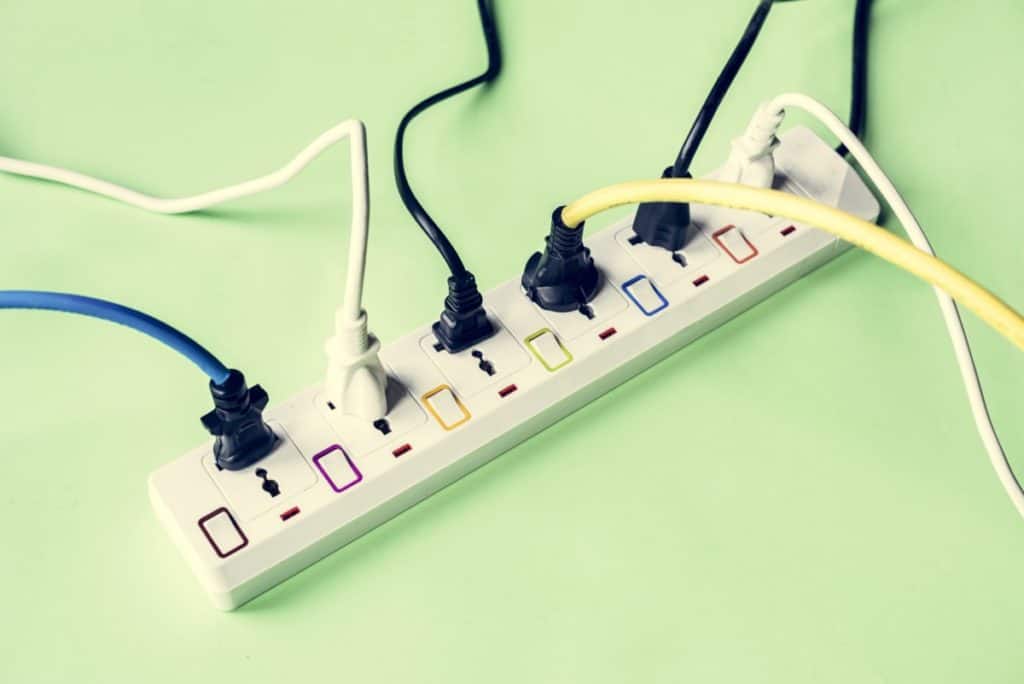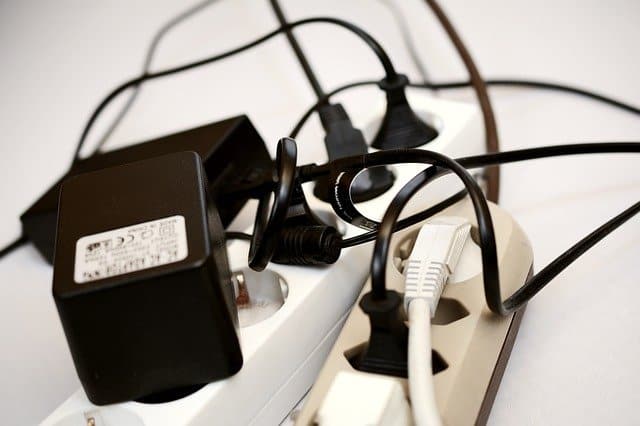Surge protectors protect your home and businesses from voltage spikes that might cause irreversible damage. However, it might be challenging to know which surge protector to choose when there are so many available on the market.
There are many different types of surge protectors. Each has its own unique features and uses. Keep reading to learn how to pick the right surge protector that will serve your electronics and belongings well in the long run based on your needs.
How to Choose the Best Surge Protector for Your Needs?
Follow these eight steps to choose the best surge protector that meets your needs:
- Assess the Weather and Power Stability in Your Area
- Choose an Indoors or Outdoors Surge Protectors
- Check Out the Surge Protector Specifications (It is ALL about the Joules)
- Consider the Best Type of Surge Protectors for Location
- Determine the Surge Protector Size & Wire Length
- Take Note of Extra plugs & Features
- Examine the Surge Protector Warranty
- Price is Not Everything!
Let’s go through the criteria one by one, in the next 10 minutes, I will help you chose the best surge protector for your needs!

1. Assess the Weather and Power Stability in Your Area
Knowing the weather in the location that you reside within is important when selecting a surge protector. You will need a more powerful surge protector if you live in a location that is prone to:
- Lighting storms (only a whole-home surge protector can guard against lightning)
- Blackouts (wall and strip surge protectors are ideal for power flickers and diruptions)
- Old or defective wiring. Is your building old? Does it suffer from worn wiring?
With any of these conditions, the likelihood of experiencing a power surge increases.
2. Indoors or Outdoors Surge Protectors?
There are outdoor varieties of surge protectors. They come in a water resistant/proof casing which provides the necessary protection from the outside elements.
Outdoor surge protectors can be a great addition if you need to plug in many things outside. However, many risks come with doing this that you may need to be aware of before investing:
- Weather damage: The weather might harm the protector and shorten its lifespan. When possible, choose a location that shields your surge protector from the elements.
- Electrocution: Though the surge protector is designed to minimize electrical damage, if it is exposed to lightning or submerged in water there is always a chance of danger in the format of electrocution. Again, choose the location carefully.
Though there are safe methods that might allow you to place a surge protector outside, it is important to keep the risks in mind. Dry elevated covered areas work best if using a surge protector outside.
It is important to note that the same does not apply to power strips. Do not place power strips outdoors, though they may look similar to surge protectors. Most Power strips are not safe for outside use.
3. Check Out the Surge Protector Specifications
There are a few technical items to take note of on your surge protectors as well. These include joules, clamping voltage, response time, and the UL 1449. All of these items should be visible right on the packaging.
If you are unsure of what these are, read on. Each of these items varies among products, so it is critical to understand what you are purchasing. The longevity of your electronics and the surge protector itself depends on these items.
It is All About the Joules!
Joules is the energy absorption ranking. In other words, it is telling you how much damage the surge protector can take before it fails. The higher the number is, the more damage a surge protector can withstand.
A 2000 Joules rated surge protector can absorb 10 times the amount of damage than a 200 Joules rated one before it fails.

But wait! There is more! Joules are cumulative. This means that if your 2000 Joules rated surge protector takes a hit worth 200 joules, it is now an 1800 Joules surge protector. That is why surge protectors do not last forever, replace your after 3-5 years.
The Ideal Amount of Joules
The number of Joules rating a surge protector is the most important number; you might wonder what the ideal amount of Joules is. While this can vary, a good minimum to set your standard at is about 2000 Joules.
Note: Unless clearly noted, all the surge protectors recommended here by SecureHomeHero are rated at 2000 Joules or more 😊
This may seem like a big number, but there are many surge protectors on the market that hold 4000 Joules. Some of the best ones sold on Amazon include:
- Anker Power Strip Surge Protector
- AmazonBasics 8-Outlet Power Strip Surge Protector
- Etekcity 6-Outlet Surge Protector
An amount this high is needed because every time a surge protector is hit, the Joules take the damage. The larger the number, the more hits can be taken. A 4000 Joule surge protector will last much longer than one that is rated at 500 Joules.
Clamping Voltage
The clamping voltage works hand in hand with the joules to ensure that the surge protector can handle the voltage that it is shocked with. The lower the number, the smaller the voltage that will be allowed to pass through to your valuable items.
The clamping voltage might also be called:
- Voltage Protection Rating (VPR)
- Suppressed Voltage Rating (SVR)
This rating is often listed on the front of the packaging as well. Look for a number lover than 350 to ensure that your electronics will not be affected by an electrical surge.
Response Time
Response time lets you know how long it will take for your surge protector to react in the case of a power surge. With this item, the lower the number is, the better.
The response time reads in terms of nanoseconds. If the number is 100, that indicates that the surge protector will take 100 nanoseconds to react to an electrical surge. That is too long! Look for surge protectors with one nanosecond response time!
UL 1449
The UL 1449 is a safety standard that ensures that the surge protector is a quality product. This seal is crucial when choosing one for your home. Make sure that the UL 1449 marking is on the front of the packaging and in plain sight.
If you find a great one that lacks this standard, it does not mean that it will not work. However, it does not guarantee that that surge protector has passed all regulatory standards. It might not be the best fit for your home.
4. Consider the Best Type of Surge Protectors for Location
Once you have figured out where you will place the device, it is time to select the surge protector you would like. There are many kinds, and it might seem a bit overwhelming at first.
There are three main categories of surge protectors; each operates in a different way to serve a similar purpose.
Three Types of Surge Protectors
There are three main types of surge protectors that you might choose from. Some are bigger than others. While the most common is the strip surge protector, you might want to invest in something a little bigger for your own home. These can also work together to get the job done.
The three main types of surge protectors, and some qualities that come with them, include the following:
| Main Function | Price | Ease of Install | Surge Protection Rating | |
| Wall/Plug Mount Surge Protector | Powers multiple devices and protects them all against power surges | The typical range is around $20 | It can simply be plugged into the wall, much like the strip protector | Low to Medium Most are 1700 Joules or less |
| Whole-Home Surge Protector | Protects against large and small surges in the main power grid | The typical range is around $150 | No. Hire a certified electrician. | Here Look for Amps Rating! 100,000 Amps or more for Lightning Protection |
| Strip/Extension Surge Protector | Powers multiple devices and protects them all against power surges | The typical range is around $30 | Easiest of all since all they require is to be plugged into a wall circuit | Good, can find a wide range. Look for 2000 Joules minimum. 4000 Joules plus is best! |
Each type of surge protector is safe and effective in its way. Moreover, assessing each type of surge protector is essential for understanding what each of them does and how they work.
Wall Mount Surge Protector
This type of surge protector is like a large block that plugs into your wall. It takes an outlet that once could only handle two items plugged into it and gives it the capacity to hold six, eight, or even ten plugs.
These are beneficial because they are easy to see on the wall, and there is no issue of hiding cords or placing them in a manner where they cannot be tripped on. They can save space in places where a strip surge protector cannot.
Some of the best wall mount surge protectors for sale on Amazon include:
- Nuozhi 6-Outlet USB Surge Protector
- 6-Outlet Nightlight Extender 1728Joules Surge Protector
- Monoprice Surge Protector
All of these are of great quality and can be purchased for a reasonable price. Invest in this one if you would like to save space and avoid the cords that come with purchasing a strip version of this product.
Strip Surge Protector
This type is perhaps the most common. From college dorms to living rooms. It offers more flexibility and a bit of an extension cord than the plug wall-mounted variety.
Some of the best strip surge protectors available on Amazon are:
- Belkin Power Strip Surge Protector
- Tripp Lite 7-Outlet Surge Protector
- Anker 12 Outlet Power Strip Surge Protector
Strip surge protectors can be beneficial because they reach farther than a wall-mounted protector. Invest in this if you value reach over the risk of tripping over an extra cord on the floor.
Whole-Home Surge Protectors
Great for areas prone to thunderstorms, whole-home surge protectors are the biggest of all. They work with the main power grid to prevent giant electrical surges that can cause extreme damage to your electrical system and the devices that it powers.
Whole-home surge protectors do not, unfortunately, defend the home from smaller electrical surges. Investing in this type of protector may be beneficial along with a small version, as the strip of wall-mounted versions.
The best whole-home surge protectors for sale on Amazon are:
- Siemens FS140 Whole House Surge Protector
- Intermatic Whole Home Surge House Protector
- EATON Ultimate Surge Protector
These are more expensive than the other two options. However, they can come in handy in the case of a huge power surge. It is important to double-check that you do not already have this kind of defense in your power grid before you invest in this item.
Look for these Additional Features of the Basic Surge Protectors
Along with the basic function of the surge protector, additional features provide nice benefits that may be right for your needs. Moreover, the prices are very reasonable, so you can save money in this process.
Surge Protector with Battery Backup
A surge protector that has battery backup is important if you are worried about losing work or progress on a computer or personal device. In the case of a surge or power outage, this extra battery will allow you to save your work and power off before losing the ability to do so.
Some of the best surge protectors on Amazon that hold extra battery power include (Please note, most battery backup surge protectors are rated at 1000 Joules or less. If you find one rated 2000 Joules or more, please email us so we can added to our recommended list):
- CyberPower Ecologic Battery Backup and Surge Protector
- Tripp Lite UPS Battery Backup Surge Protector
- APC Battery Backup and Surge Protector
These are a bit more pricey than the regular surge protector. However, if you are worried about power outages, it can be very beneficial. The extra battery backup can be a savior for any document that would otherwise be lost in the case of a power surge or outage.
The right battery backup surge protector can even charge your devices and run your Wi-Fi internet for several hours during a power outage. You can learn how in this SecureHomeHero article.
Flexible Outlet Adaptors
Do you have an odd-shaped plug or a tight area between your furniture and wall plug? Flexible surge protectors can solve this problem. They create pluggable methods that rotate in various directions to avoid damage and wear from twisting and turning power cords to plug into a wall outlet.
Some excellent outlet adaptors for sale on Amazon include:
- Belkin Power Strip with Pivot Outlets
- EcoGear Surge Protector with Rotating Plugs
- USB Wall Charger with Rotating Side Power Strip
Power Saving & Timer Surge Protectors
Energy waste is a big problem. Every single day, we waste electricity that could otherwise be going to good use.
Power-saving surge protectors help to conserve energy. They turn off or go to sleep when products are plugged in but not in use. These are ideal if you would like to save money and the environment.
Outdoor Surge Protectors
As discussed earlier, there are weatherproof surge protectors that can be used outside. These provide the additional benefit of casing that can withstand the elements and avoid electrical dangers better than those like it.
Outdoor surge protectors can power construction equipment, exercise devices, and even a television. They provide power in the most unexpected of places.
Some of the best outdoor surge protectors that you can invest in on Amazon include:
- ESHLDTY 8-Plug USB Outdoor 1500 Joules Surge Protector
- ESHLDTY RGB Power Tower, 1 USB C 3 USB Ports 9 AC Outlets
Another great option that opens endless possibilities and provides superior protection are Connection Weatherproof boxes:
All of these are safe and affordable options if you need the additional benefit of power outlets outside. If you invest in any other device, ensure that it is water-resistant (IPX4 or higher) and will stand up against the elements. You do not want to put yourself in any unnecessary danger.
5. Determine the Surge Protector Size & Wire Length
Once you have narrowed down the kind of product that you would like, you should consider the size that you will need. There are many different styles and shapes, but some may not fit what you are looking for.
The two primary considerations are the number of plugs and the length of the cord. The size of the product
- How many devices can be plugged in at one time
- Do you anticipate that you will need more in the future?
If you have seven devices, consider getting a surge protector for ten.
Strip surge protectors are often plugged into the wall using a cord. These can range anywhere from two to fifteen feet.

- If a cord is too short, it will not reach the distance that you would like it to. In general, you want to avoid plugging extension cords or power strips into a surge protector.
- If the cord is too long, it may get in the way and become hard to deal with
6. Take Note of Extra Surge Protector Features
Many surge protectors come with bonus features that help improve the quality of the surge protector itself and enhance it with extra details. These vary from product to product.
Some of the most common extra features include:
- Replacement indicator lights, which is a great feature that tells you when the time has come to replace the surge protector.
- Energy-saving timers that will shut off the power when it is not needed
- LED displays for the ability to control in the dark
- USB ports for the ability to plug in even more devices on the side
Additional features may make the product more expensive, but for many, this additional cost is worth it. For example, replacement indicator lights can save you from a potentially disastrous situation, as you will be warned before your surge protector is going to fail.
7. Examine the Surge Protector Warranty
Warranties tend to come with many surge protectors. They range from product to product, often depending on the company that created them. Warranties cover damaged surge protectors and often the equipment that is attached to them.
Warranties often come inside the box. Ensure you read up on them before staking your claim on any money for a damaged product.
Read the Fine Print
The fine print of a warranty clarifies just what it covers. On top of the general description included with the product, make sure you read the fine detail listed at the bottom. These will discuss:
- How much money the warranty can cover
- Whether the warranty covers just the surge protector or includes the items plugged into it
- How long the warranty lasts
Sometimes, a warranty is only good for a year. Some are for a lifetime. This is good to know if you think this item will be important for your electronics in the future. The fine print can either cause you or save you a lot of trouble, depending on if you read it or not.
8. Price is Not Everything!
A cheap surge protector might end costing you thousands if it fails to protect your valuable devices. Put together the features you would like to see first, and only then look at the prices that meet your criteria. Quality is worth it.
Once you have done that, you should have the perfect surge protector for your home. You can plug it in and use it as you would like. At the same time, your electronics will be safe from the danger of power surges.
Conclusion
Surge protectors are essential devices that protect your electronics, medical appliances and more. Choose one that fits your space, has enough plugs, with at least 2000 Joules rating. Additional features such as replacement indicator lights and USB ports are good to have. For outdoor use, make sure to choose a surge protector that is specifically designed to withstand the weather, or opt for a waterproof connection box.

